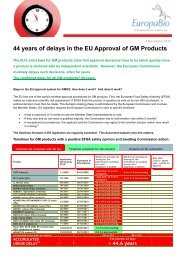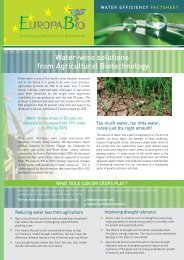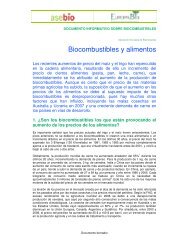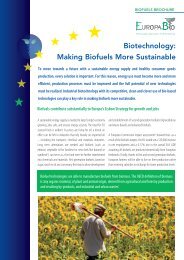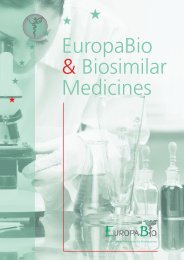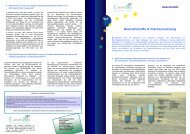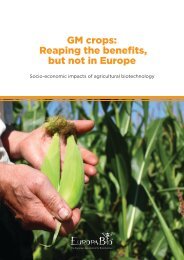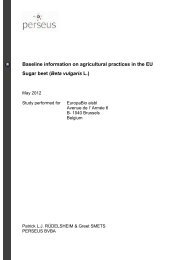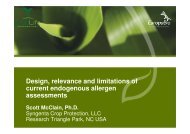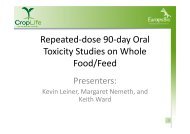Design of in vitro protein digestibility d h i l h i k assays ... - Europabio
Design of in vitro protein digestibility d h i l h i k assays ... - Europabio
Design of in vitro protein digestibility d h i l h i k assays ... - Europabio
Create successful ePaper yourself
Turn your PDF publications into a flip-book with our unique Google optimized e-Paper software.
<strong>Design</strong> <strong>of</strong> <strong>in</strong> <strong>vitro</strong> prote<strong>in</strong> <strong>digestibility</strong><br />
<strong>assays</strong> and d their h i relevance l to the h risk ik<br />
assessment<br />
Clare Mills<br />
Institute <strong>of</strong> Inflammation and Repair<br />
The University <strong>of</strong> Manchester
Declaration <strong>of</strong> Interests<br />
Research fund<strong>in</strong>g<br />
• UK Biological and Biotechnological Sciences Research<br />
Council<br />
• UK Technology T h l Strategy St t BBoard dP Project j t( (collaborative ll b ti with ith<br />
Waters Corporation, Romer Labs, The Laboratory <strong>of</strong> the<br />
Government Chemist)<br />
• UK Food Standards Agency (contractor to Food Allergy<br />
Branch; member <strong>of</strong> the Advisory Committee on Novel<br />
Foods and Processes [ACNFP]*) [ACNFP] )<br />
• European Union –CHANCE<br />
• Novartis, , DBV Technology gy<br />
• European Food Safety Authority
Why is <strong>digestibility</strong> important for<br />
food allergy? gy
Lipid<br />
droplets<br />
Events <strong>in</strong> the gut lumen affect<strong>in</strong>g prote<strong>in</strong><br />
release and breakdown<br />
Lipid‐adsorbed<br />
allergen<br />
Impact on release<br />
ffrom <strong>in</strong>tact i t t<br />
cells<br />
Proteolysed<br />
prote<strong>in</strong><br />
aggregates<br />
Resistant<br />
allergen<br />
Prote<strong>in</strong><br />
stabilised<br />
emulsions<br />
How does the form <strong>of</strong> a<br />
prote<strong>in</strong> determ<strong>in</strong>e its<br />
release from food and<br />
stability to digestion?
Uptake and <strong>in</strong>tracellular process<strong>in</strong>g <strong>of</strong> allergens…….<br />
HHow do d prote<strong>in</strong>s i cross the h mucus<br />
layer?......<br />
……and how does this affect their uptake p by y the<br />
epithelium and immune cells.............<br />
……. mak<strong>in</strong>g g an antigen g <strong>in</strong>to an allergen? g<br />
Maciercenka, et al 2011 S<strong>of</strong>t Matter 7 (18) 8077‐8084
This is important for<br />
•Elicitation <strong>of</strong> allergic g reactions <strong>in</strong> sensitised<br />
<strong>in</strong>dividuals<br />
•Severity Severity <strong>of</strong> reaction and conditions like exercise‐ exercise<br />
<strong>in</strong>duced anaphylaxis<br />
•Affect<strong>in</strong>g Affect<strong>in</strong>g the balance between tolerance and<br />
sensitisation to dietary prote<strong>in</strong>
Digestion also plays an important role <strong>in</strong><br />
antigen presentation<br />
The endosome – a “stomach stomach <strong>in</strong>side a cell” cell is <strong>in</strong>volved <strong>in</strong><br />
•Generat<strong>in</strong>g peptides taken up by a diverse range <strong>of</strong><br />
cells<br />
•pH is ~2<br />
•Proteases <strong>in</strong>clude aspartate and cyste<strong>in</strong>e proteases<br />
•R •Redox d enzymes such h as γ‐<strong>in</strong>terferon i t f llysosomal l<br />
thioreductase (GILT)<br />
Hast<strong>in</strong>gs and Cresswell (2011) ANTIOXIDANTS & REDOX SIGNALING 15: 657‐668
Digestibility and allergenicity risk assessment<br />
Digestibility g ystudies provide p useful data regard<strong>in</strong>g g gthe<br />
properties and characteristics <strong>of</strong> the novel prote<strong>in</strong> affect<strong>in</strong>g<br />
•Gut llum<strong>in</strong>al i lprocess<strong>in</strong>g i and d uptake k<br />
•Intracellular process<strong>in</strong>g and antigen presentation<br />
These may <strong>in</strong>fluence properties such as tolerance <strong>in</strong>duction<br />
or sensitisation <strong>in</strong> a host.<br />
They may also provide data on the stability and molecular<br />
mobility bili <strong>of</strong> f polypeptide l id cha<strong>in</strong>s hi<br />
MMutschlechner hl h et al l J Allergy All Cli Cl<strong>in</strong> IImmunoll2010 2010;125:711‐8<br />
125 711 8
Gastroduodenal digestion and the gut as a<br />
bi biological l i lprocess<strong>in</strong>g i plant l<br />
Biomechanics and motility y determ<strong>in</strong>e<br />
lum<strong>in</strong>al flow and mix<strong>in</strong>g behaviour<br />
+<br />
Variation <strong>in</strong> activity, content and<br />
secretion <strong>of</strong> digestive enzymes<br />
Determ<strong>in</strong>e the rate <strong>of</strong> delivery <strong>of</strong><br />
absorbable species to the gut wall<br />
All <strong>of</strong> this is under tight biological control, <strong>in</strong>clud<strong>in</strong>g<br />
gut‐bra<strong>in</strong> signall<strong>in</strong>g<br />
9
Dynamic y a cGast Gastric c Model ode ( (DGM): G ): Full u ssimulation uato o<strong>of</strong> gast gastric c<br />
forces and motility<br />
Ma<strong>in</strong> Body:<br />
Gentle 3 contraction<br />
wave<br />
per p m<strong>in</strong> cycle y<br />
In‐homogenously mixed<br />
environment<br />
AAntrum: t<br />
High shear well mixed<br />
environment<br />
Shear at 10‐100 sec 1 ‐1<br />
Phase II contraction waves<br />
Inventors: Mart<strong>in</strong> Wickham, Richard Faulks<br />
Licensed to PBL
Dynamic Duodenal Model: comb<strong>in</strong><strong>in</strong>g<br />
segmented and peristaltic flow.<br />
Bostjan Hari, Serafim Bakalis, Peter Fryer,<br />
UUniversity i i <strong>of</strong> f Birm<strong>in</strong>gham<br />
Bi i h
β‐Lactoglobul<strong>in</strong> β Lactoglobul<strong>in</strong> ‐ normally resists peps<strong>in</strong>olysis<br />
<strong>in</strong> solution but is partially digested as an<br />
emulsion<br />
β-Case<strong>in</strong>: Emulsification alters the digestion k<strong>in</strong>etics<br />
<strong>of</strong> giv<strong>in</strong>g g g rise to Mr 6,000 , resistant peptides p p<br />
Maceirczenka et al S<strong>of</strong>t Matter 2009;5(3):538‐550<br />
; ( )<br />
T=60m<strong>in</strong>
Physical models <strong>of</strong> digestion are<br />
Mimics Mimics <strong>of</strong> flow and mix<strong>in</strong>g behaviour <strong>in</strong> the GI<br />
tract<br />
Addition Addition <strong>of</strong> digestive enzymes and pH adjustment<br />
more like a “real” gut<br />
<strong>Design</strong>ed es g ed to dgest digest real ea foods oods aand dmeal‐sized ea s ed<br />
portions<br />
Easier to sample p than human volunteers<br />
X Not necessarily validated aga<strong>in</strong>st the human<br />
situation<br />
XNot adapted to analysis <strong>of</strong> small amounts <strong>of</strong><br />
material or purified p prote<strong>in</strong> p
Modell<strong>in</strong>g Digestion –Biochemical Biochemical Models<br />
pH 2.5<br />
I=0.15<br />
Sh Shake, k 37ºC<br />
Shake Shake, 37ºC<br />
Sample over<br />
time<br />
pH 7.5<br />
I=0.15<br />
pH 6.5<br />
I=0.15<br />
Gastric mix:<br />
Stop gastric<br />
Duodenal mix:<br />
Peps<strong>in</strong><br />
digestion by Tryps<strong>in</strong>,<br />
Phosphatidyl addition <strong>of</strong> chymotryps<strong>in</strong><br />
chol<strong>in</strong>e h li vesicles il NOH NaOH Li Lipase/colipase / li<br />
Amylase<br />
Bile salts<br />
Sample over<br />
time<br />
pH 6.5<br />
I=0.15<br />
Stop duodenal<br />
digestion by<br />
addition <strong>of</strong>SBTI or<br />
PMSF
Unfold<strong>in</strong>g <strong>of</strong> prote<strong>in</strong>s at gastric pH: Bet v 1<br />
homologues unfold at low pH<br />
AApi ig 1 partially illunfolds f ld at pH2.5 H2 5<br />
BUT<br />
Mal d 1 is completely unfolded<br />
Sancho, et al 2011 Mol Nutr Food Res. 55(11):1690‐9.
Peach LTP is highly resistant to peps<strong>in</strong>olysis<br />
IIt has h many candidate did peps<strong>in</strong> i cleavage l sites i but b iis<br />
completely resistant to digestion <strong>in</strong> its native<br />
folded form<br />
Wijes<strong>in</strong>ha‐Bettoni j et al 2010 Biochemistry. y 49(10):2130‐9. ( )
Duodenal digestion ‐ only 2 out <strong>of</strong> 14 tryptic and<br />
chymotryptic are hydrolysed!<br />
Chymotryps<strong>in</strong> Tryps<strong>in</strong> yp<br />
Three digestion products can be<br />
Unreduced<br />
identified – residues 1‐79 1 79, 1‐39 1 39 and<br />
40‐79 which are only observed <strong>in</strong><br />
unreduced prote<strong>in</strong>
Local side cha<strong>in</strong> dynamics may expla<strong>in</strong> preferential<br />
cleavage <strong>of</strong> certa<strong>in</strong> sites<br />
Residues <strong>in</strong> cleavage sites are more mobile<br />
This may allow more effective location <strong>of</strong> side<br />
cha<strong>in</strong>s <strong>in</strong>to protease specificity pockets
Biochemical models <strong>of</strong> digestion<br />
Can Can be scaled down to analyse small amounts <strong>of</strong><br />
s<strong>in</strong>gle prote<strong>in</strong>s<br />
Some Some collaborative trials published show<strong>in</strong>g <strong>in</strong>ter‐ <strong>in</strong>ter<br />
laboratory validation<br />
Homogeneously o oge eous y mixed ed so sa sampl<strong>in</strong>g p g is s eas easier e<br />
Can mimic the GI tract‐ a model system with<br />
assumptions p and limitations [enzyme:substrate<br />
[ y<br />
ratios, pH titration, homogeneous mix<strong>in</strong>g]<br />
XNot well suited to analysis y <strong>of</strong> foods [sampl<strong>in</strong>g, [ p g,<br />
soluble versus <strong>in</strong>soluble phases]
How to measure digestiblity?
SDS‐PAGE and IgE b<strong>in</strong>d<strong>in</strong>g capacity:<br />
Bet v 1 homologues susceptible to gastric<br />
di digestion ti<br />
MMass spectrometry t t mapp<strong>in</strong>g i <strong>of</strong> f digestion di ti products d t –<br />
A way <strong>of</strong> pr<strong>of</strong>il<strong>in</strong>g peptides<br />
Cleavage patterns are similar for both prote<strong>in</strong>s but Api g<br />
1 is digested more slowly than Mal d 1<br />
IE IgE epitopes it are ddestroyed t dbbut tdi digestion ti products d t can<br />
still activate T‐cells<br />
Sancho, et al 2011 Mol Nutr Food Res. 55(11):1690‐9.
Gastric Gast c digestion dgesto <strong>of</strong> o pea peanut ut Araa h 1 does not ot<br />
alter its allergenic activity<br />
PC<br />
0 1 2 4 8 16 30 60 90 120 m<strong>in</strong><br />
Ara h 1<br />
Eiwegger, Rigby et al Cl<strong>in</strong> Experimental Allergy 2006<br />
releasee<br />
is ta m <strong>in</strong><br />
% H<br />
80<br />
60<br />
40<br />
20<br />
0<br />
Ara h 1<br />
Ara h1 Phase 1<br />
Phase 1+2 Digestion Fluid P1<br />
Digestion Fluid P1+2 Gastro‐duodenal<br />
Gastric Gast c digestion dgesto<br />
MMedium di<br />
control<br />
0001 0.001 001 0.01 01 0.1 1<br />
Concentration (µg/ml)<br />
di digestion i
Tests for resistance to gastroduodenal g digestion g<br />
Validation is needed regard<strong>in</strong>g<br />
•Levels L l <strong>of</strong> f enzymes and d bi biosurfactants f [h [these<br />
change with age, food composition]<br />
•Standardisation S d di i <strong>of</strong> f mix<strong>in</strong>g ii conditions di i<br />
•Interlaboratory comparisons<br />
•Agreed A d“ “outcome” ” measures (SDS (SDS‐PAGE, PAGE<br />
mass spectrometry to monitor digestion <strong>of</strong><br />
polypeptides, l tid bi bioactivity ti it measurements t lik like<br />
IgE b<strong>in</strong>d<strong>in</strong>g, T‐cell reactivity)<br />
NB –variation <strong>in</strong> outcomes <strong>of</strong> <strong>in</strong>terlaboratory trials maybe<br />
determ<strong>in</strong>ed more by measurement and sampl<strong>in</strong>g than the<br />
protocol per se!
Peps<strong>in</strong> resistance test
1996: Astwood et al identify a correlation between<br />
resistance to peps<strong>in</strong> digestion and allergenicity [Nat<br />
Biotechnol. 1996 Oct;14(10):1269‐73.]. This<br />
•Posed the hypothesis ‘that food allergens must exhibit<br />
sufficient gastric stability to reach the <strong>in</strong>test<strong>in</strong>al mucosa<br />
where absorption and sensitization (development <strong>of</strong><br />
atopy) can occur.’<br />
BUT<br />
•The test is non physiological<br />
•the pH is lower than found <strong>in</strong> vivo and changes<br />
peps<strong>in</strong> specificity,<br />
•Peps<strong>in</strong> is present <strong>in</strong> a gross excess which affects<br />
k<strong>in</strong>etics <strong>of</strong> digestion
Is the peps<strong>in</strong> resistance test more a biochemical<br />
surrogate <strong>of</strong> “stability” than simulated gastric digestion?<br />
•Peps<strong>in</strong>, like other endoproteases (tryps<strong>in</strong>, chymotryps<strong>in</strong>)<br />
cleaves mobile, surface accessible sites on a substrate<br />
•Resistance to peps<strong>in</strong>olysis is a function <strong>of</strong><br />
•Resistance Resistance to low pH unfold<strong>in</strong>g<br />
•Polypeptide mobility at the cleavage site<br />
•Resistance to peps<strong>in</strong> maybe a surrogate measure <strong>of</strong><br />
endosomal process<strong>in</strong>g <strong>in</strong>volved <strong>in</strong> antigen presentation<br />
•It may hhave validity ld as a correlative l test def<strong>in</strong>ed df dus<strong>in</strong>g<br />
panels <strong>of</strong> “allergens” and “non‐allergens” <strong>in</strong>cluded <strong>in</strong> the<br />
i<strong>in</strong>tegrative i risk ikassessment approach<br />
h
In <strong>vitro</strong> prote<strong>in</strong> <strong>digestibility</strong> <strong>assays</strong> and their<br />
relevance to the risk assessment<br />
•Simulated Gastroduodenal Digestion provides<br />
<strong>in</strong>formation relevant to understand<strong>in</strong>g the context <strong>of</strong><br />
how a prote<strong>in</strong> is presented to the immune system <strong>in</strong> a<br />
physiologically relevant context<br />
•The Peps<strong>in</strong> Resistance Test is a dist<strong>in</strong>ctly different<br />
biochemical test which provides complimentary<br />
<strong>in</strong>formation on the biochemical stability <strong>of</strong> a prote<strong>in</strong><br />
which may be predictive <strong>of</strong> allergenic potential<br />
(<strong>of</strong> course if we had a good animal model we would<br />
not have to rely on these tests so much!)
Manchester Team: Phil Johnson, Claire Eyers, Adnan Custovic,<br />
Angela l Simpson, Mark k Travis, John h McLaughlan hl<br />
IFR Team: Neil Rigby, Guisy Mandalari, Andrew Watson, Alan<br />
MMackie ki<br />
Past Team Members: Javier Moreno, Ana Sancho, Yuri<br />
Al Alexeev, Emi E iVVassilopolou, il l JJohn h Jenk<strong>in</strong>s J ki<br />
Collaborators: Peter Shewry, Lorna Smith, Jean‐Michel Wal,<br />
KKar<strong>in</strong>e i ZZsolt ltSSzefalusi, f l i Nik Nikos PPapadopolous, d l BBarbara b Ballmer‐ Bll<br />
Weber, Charlotte Madsen<br />
Plus l numerous other h UK and d European collaborators! ll b !<br />
Protall



